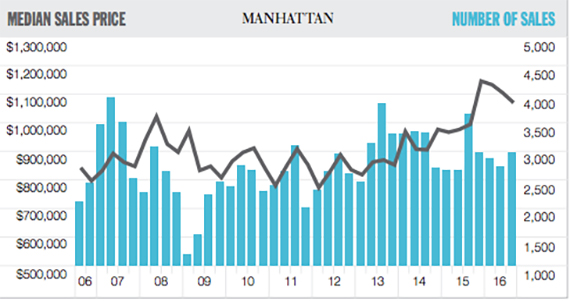Trending
Bidding wars slow amid spike of supply in Manhattan’s residential market
Sales in Q3 dropped 18.6% year-over-year

In 2015, buyers engaged in fierce bidding wars for Manhattan homes, ready to pay thousands more than the seller was asking. A year later, that frenetic game of inverse limbo (how high can you go?) seems to be slowing down.
In the third quarter of 2016, fewer homes were sold above the initial asking price and discounts were on the rise, according to Douglas Elliman’s latest market report.
Only 17.4 percent of residential sales were above the listing price — compared to 31 percent at the same time last year, Jonathan Miller [TRDataCustom], the author of the Elliman report and CEO of Miller Samuel Real Estate Appraisers and Consultants, told The Real Deal. Meanwhile, listing discounts rose to 2.9 percent, up from 2.2 percent in the third quarter of 2015, according to the report.
The influx of inventory — both re-sale and new — has helped curb bidding wars, Miller said. Resale listing inventory reached 5,290, an 8.2 percent year-over-year increase. The spike is modest compared to the second quarter’s infusion of 25 percent more resale inventory, but shows that the supply is steadily growing. New development inventory rose 27.2 percent from this time last year, reaching 973 listings in the third quarter.
Demand, however, is not quite offsetting the overall supply. This quarter saw a precipitous drop in sales, falling 18.6 percent from the same time last year. Miller pointed out that the number of sales is still actually 7.2 percent higher than the 10-year quarterly average and nearly 18 percent higher than the 20-year average. He said that the market was “distorted” over the last few years by unusually high sales volumes — now, it’s simply correcting itself.
“It’s still well above sales levels of the last decade,” Miller said. “Sales activities are still pretty high.”
In a separate report, the Corcoran Group noted that while there’s an oversupply of inventory on the high end of the market, there still isn’t enough inventory on the lower end to meet the high demand from buyers. As TRD reported last week, developers are increasingly moving supply into the $1 million-to-$3 million market, which has a deeper buyer pool.
Though the median sales price rose 7.6 percent year-over-year, the number is skewed by the fact that a majority of the sales that closed this quarter were new development units that went into contract more than a year ago, according to the Elliman report. The median sales price in the third quarter was $1.1 million, up from $998,000 at the same time last year.




